![]()
Created by: Paul d'Ivoi (Paul Deleutre) (1856-1915)
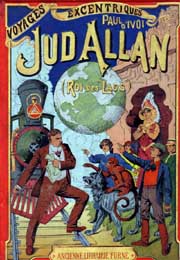
 Paul d'Ivoi was by far the most commercially prosperous and influential
successor of Jules Verne. He was the author
of the 21-volume series, Les Voyages Excentriques
(Eccentric Voyages) intended to compete
with Verne's Les Voyages Extraordinaires
(Extraordinary Voyages), which were for
the most part first serialized in Le Journal des Voyages, then published in book form by Furne between 1894 and 1914. Both Deleutre's father and grand-father
were men of letters themselves, and had used the nom-de-plume "d'Ivoi" previously. Young Paul started
a a literary critic and chronicler at the Journal des Voyages before embarking on a career as a novelist.
Paul d'Ivoi was by far the most commercially prosperous and influential
successor of Jules Verne. He was the author
of the 21-volume series, Les Voyages Excentriques
(Eccentric Voyages) intended to compete
with Verne's Les Voyages Extraordinaires
(Extraordinary Voyages), which were for
the most part first serialized in Le Journal des Voyages, then published in book form by Furne between 1894 and 1914. Both Deleutre's father and grand-father
were men of letters themselves, and had used the nom-de-plume "d'Ivoi" previously. Young Paul started
a a literary critic and chronicler at the Journal des Voyages before embarking on a career as a novelist.
D'Ivoi's novels were more adventure-oriented than Verne's, and were written in a faster paced, pulp/serial style.
They were meant to entertain more than educate. They included a variety of futuristic machines such as incredible
planes, sub-marines, rocketships, super-powered weapons, etc. Their heroes circumnavigated the globe, explored
the bottom of the oceans, or conquered the atmosphere. They fought a dazzling variety of mad scientists, international
conspiracies, and megalomaniacal tyrants. They unearthed evidence of ancient advanced civilizations. In short,
they did everything pulp heroes of that time, like The
Nyctalope, did.
Finally it is worth noting that, as was the case with Verne, through a series of cross-references, most of d'Ivoi's
heroes share the same fictional universe, if they are not actually related to each other.
Cigale is a young Parisian
orphan boy who met a strange Hindu, the inventor of a prodigious multi-purpose vehicle dubbed the "Electric
Hotel", and nicknamed him "Docteur Mystère" in the eponymous 1900 novel. In MARTIN MYSTÈRE
Nos. 174 and 175 (Sept.-Oct. 1996), in a story entitled Affari di Famiglia [Family Business],
writer Alfredo Castelli and artist Giancarlo Alessandrini revealed that Docteur
Mystère later fought for India's independence, took part in the 1885
national congress, and eventually adopted Cigale,
taking the legal name of "Mystere" under which he was widely known. Cigale was revealed to be Martin
Mystère's great-great-grand-father.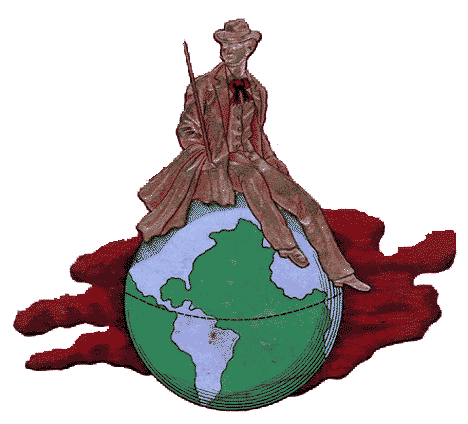

Paul d'Ivoi's best known hero, Armand
Lavarède, is a fearless, daring young man who made his first appearance
in Les Cinq Sous de Lavarède [The Five Pennies Of Lavarede] (1894), the first of the
Eccentric Voyages. The novel is an Around the World in 80 Days variation in which the hero
embarked on a Phileas Fogg-like journey around the world with only five pennies in his pocket.
The novel was adapted into a 1927 movie directed by Maurice
Champreux, and again in 1939 in a version starring Fernandel.
Lavarède returned in Le Cousin de Lavarède
[Lavarede's Cousin] (1897), which featured
a super-powered flying speedster with movable wings and compressed air guns named the Bolide or the Gypaete. In
it, Lavarede flew to the North Pole and discovered a lost Roman civilization. We met his cousin, Robert, who became implicated in a plot to liberate Egypt
from the British Empire.
Meanwhile, Jean Fanfare
made his first appearance in the eponymous 1897 novel.
Robert Lavarède then fled to Australia
and met the Corsair Triplex
in Le Corsaire Triplex (1898), a variation
on both Twenty Thousand Leagues Under The Sea,
because its hero is the Captain Nemo-like
master of the advanced Karrovarka, an electrically-powered fortress that can travel over land or under sea, and
The Count of Monte-Cristo, for its revenge-motivated
plot. The two Laverèdes assisted
Triplex in his revenge scheme, and met
Jean Fanfare. We learn that the Karrovarka
was the invention of a Greek scientist who designed it to free Crete from the Turks.
The Lavarèdes returned in La Capitaine Nilia (1898) where, with the help of the
Karrovarka, they helped liberate Egypt, and caused England to lose much of its colonial empire.
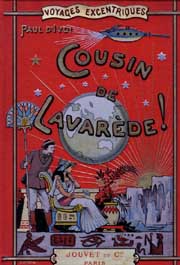
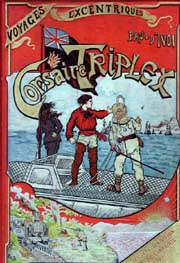
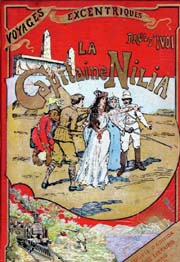
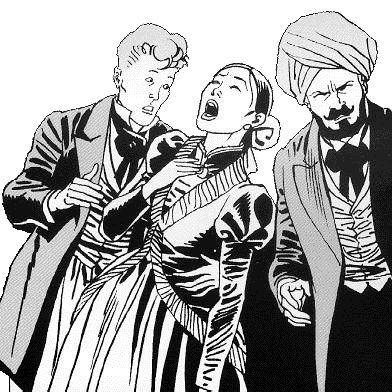

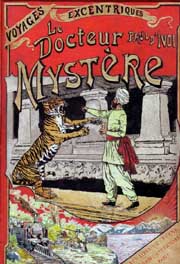
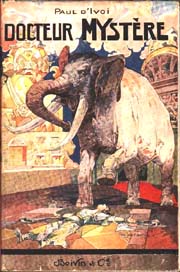
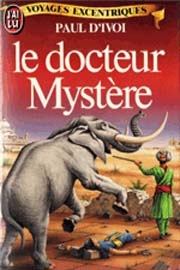

Docteur Mystere is a Hindu
Prince named Rama Rundjee whose family
was massacred by the traitorous Arkabad,
and a unholy alliance between the Thugee and the Russians. Rundjee eventually returned to India as a Captain Nemo-like
scientist-adventurer, accompanied by his fiancée Na-Indra and young Cigale to claim his revenge.
Cigale met and fell in love with Anoor. The news of false death led him to China, where
he took part in the famous siege of the legations in Cigale in China (1901), which also stars Jean Fanfare.
Cigale is in America when he met Massiliague de Marseille (1902) and prevented a war between
South and North America.
Cigale eventually found his long-lost
father in South America and had other adventures including Les Semeurs de Glace [The Seeders Of Ice]
(1903) which dealt with the explosion of the Montagne Pelée.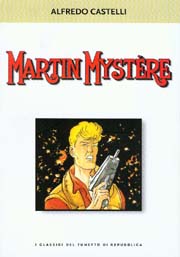
Later, Castelli and artist Lucio Filippucci embarked on telling heretofore untold
adventures of Docteur Mystère and
Cigale. In the first volume, entitled
LES MYSTÈRES DE MILAN [The Mysteries of Milan] (Erko, 2003), Doctor Mystère
and Cigale fought the combined schemes of Fu-Manchu
and former Fieldmarshal Joseph Franz Karl von Radetzky.
The book includes cameos by Peter Pan,
"Enrico" (the Phantom of the
Scala), Mackie Messer aka Mack the Knife,
Professor Spallanzani aka Professor Pince aka Fagin aka the future Wizard of
Oz, and Prof. Henry Higgins (from Shaw's Pygmalion).
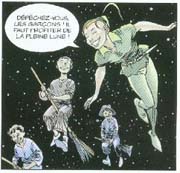
Peter Pan
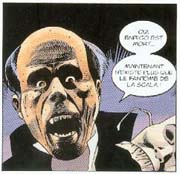
Enrico
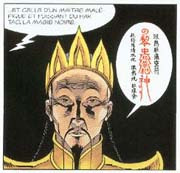
Fu-Manchu
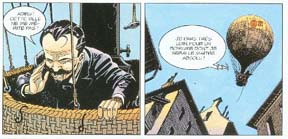
Prof. Spallanzani

| MISS MOUSQUETERR Miss Violet Mousqueterr (1907) uses light as a super-weapon to defeat a secret Hindu cult. THE ILLUSION KNIGHT Le Chevalier Illusion (1913) is yet another hero who uses a mind-control device to fight his enemies. |
|
Le Journal des Voyages: Famous French
weekly "magazine which started in 1875 as "Sur Terre & Mer" [On Land & On Sea],
then took its definitive title in 1877. The Journal des Voyages was chauvinistic, xenophobic, and yet surprisingly visionary in tone. It serialized novels
by Louis Boussenard, Paul d'Ivoi, René Thévenin, Albert Bonneau, Maurice Champagne, G. Le Wailly,
Capitaine Danrit, and many others. Its publishing history spanned over seventy years:
-- 1st series (1877-1896), 1012 issues published;
-- 2nd series (1896-1915): 941 issues published;
-- 3rd series (1924-25): 29 issues published;
-- 4th series (1925-29): 159 issues published;
-- 5th (last) series (1946-1949): 149 issues published.

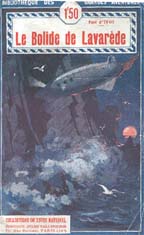 1. Les Cinq Sous de Lavarède [The
Five Pennies Of Lavarede] (Furne, 1894; rev. Tallandier, 1924)
1. Les Cinq Sous de Lavarède [The
Five Pennies Of Lavarede] (Furne, 1894; rev. Tallandier, 1924)
2. Le Sergent Simplet [Sergeant Simple] (Furne, 1895; rev. Tallandier, 1929)
3. Le Cousin de Lavarede [Lavarede's Cousin] (Furne, 1897; rev. Tallandier, 1924
-- sometimes known as Le Bolide de Lavarède [Lavarede's Speedster])
4. Jean Fanfare (Furne, 1897; rev. Tallandier,
1930)
5. Le Corsaire Triplex [Corsair Triplex] (Furne, 1898; rev. Tallandier, 1925)
6. La Capitaine Nilia [Captain Nilia] (Furne, 1898; rev. Tallandier, 1925)
7. Docteur Mystère [Doctor Mystery] (Furne, 1900; rev. Tallandier, 1926)
8. Cigale en Chine [Cigale
in China] (Furne, 1901; rev. Tallandier, 1927)
9. Massiliague de Marseille [Massiliague From Marseilles] (Furne, 1902; rev. Tallandier,
1926)
10. Les Semeurs de Glace [The Seeders Of Ice] (Furne, 1903; rev. Tallandier, 1926)
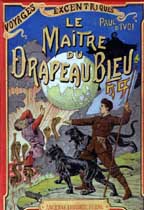 11. Le Serment de Daalia [Daalia's
Oath] (Furne, 1904; rev. Tallandier, 1925)
11. Le Serment de Daalia [Daalia's
Oath] (Furne, 1904; rev. Tallandier, 1925)
12. Le Prince Virgule [Prince Comma] (Furne, 1905; rev. Tallandier, 1928)
13. Le Maître du Drapeau Bleu [The Master Of The Blue Flag] (Furne, 1907; rev. Tallandier,
1927)
14. Miss Mousqueterr (Furne, 1907; rev.
Tallandier, 1928)
15. Jud Allan, Roi des Lads [Jud Allan, King Of The Lads] (Furne, 1907; rev. Tallandier,
1928)
16. Le Roi du Radium [The King Of Radium] (Furne, 1909; rev. Tallandier, 1927)
17. L'Aéroplane Fantôme [The Phantom Airplane] (Furne, 1910; rev. Tallandier, 1929)
18. Les Voleurs de Foudre [The Stealers Of Lightning] (Furne, 1910; rev. Tallandier,
1925)
19. L'Ambassadeur Extraordinaire [The Extraordinary Ambassador] (Furne, 1911; rev. Tallandier,
1925)
20. Le Chevalier Illusion [The Illusion Knight] (Furne, 1913; rev. Tallandier, 1926)
21. L'Évadé Malgré Lui [Escaped In Spite Of Himself] (Furne, 1914)
Thanks to Alfredo Castelli, Gérard Morvan & Marc Madouraud.